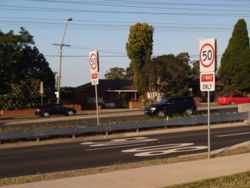T-way
 | |
| Overview | |
|---|---|
| Owner | Transport for NSW |
| Locale | Sydney |
| Transit type | Bus rapid transit |
| Operation | |
| Operator(s) | Transit Systems Sydney, Busways and Hillsbus |
| Technical | |
| System length | 90 km (56 mi) |


T-way or a transitway is a bus rapid transit line in the western suburbs of Sydney, Australia. T-ways are bus-only roads where undeveloped railway and motorway corridors are available, and bus-only lanes on existing roads. T-ways were conceived as an alternative to commuter railway services because of the lower cost and higher flexibility that they offer. T-ways can be constructed without the need for a dedicated corridor or tunnel. Buses can join and leave the T-way along the route, giving the T-way a wider feeder area than rail.
The NSW Government advocated T-ways in order to meet the growing public transport needs of Western Sydney in a planning document called Action for Transport 2010. The plan called for 90-kilometre-long bus rapid transit network linking a number of major centres west of Strathfield. To date, only two T-ways have been completed Liverpool-Parramatta & North-West T-Way.
T-ways can be used only by rapid bus services, selected local bus services and emergency vehicles. Other motorists using a bus lane (except to turn or overtake) can be fined. Other bus-only roads in Sydney include one at Moore Park and a dedicated roadway in the centre of the M2 Hills Motorway. Sydney has a large and expanding network of bus-only lanes on main roads.
Liverpool-Parramatta T-way
The line runs through the central business district of Parramatta, before heading onto the Great Western Highway to South Wentworthville, after which it heads onto its own alignment next to the Sydney Water pipeline that runs from Prospect reservoir. It then proceeds on its own alignment in an old freeway reservation through to Hoxton Park. At Brickmakers' Creek in Liverpool it heads onto its own alignment to access the main centre of Liverpool and the railway station bus interchange. This bus service is operated by Transit Systems Sydney.
North-West T-way
The T-way consists of two sections, one linking Parramatta railway station and Rouse Hill, the other linking Blacktown and Parklea. The lines intersect at Burns interchange in Parklea.
For the most part, stops are named for the streets they sit on.
The T-way was approved in February 2004 and the Rouse Hill to Parramatta section opened on March 10, 2007. The Blacktown to Parklea section started Bus services on Sunday 11 March 2007.
The planned extension of the Blacktown and Parklea T-way to Castle Hill has not been built as planned.
Future T-ways
The 1998 Action for Transport 2010 plan called for seven T-ways to be constructed by 2010 that provided a high frequency public transportation network linking employment and growth centres. Most of the proposed T-ways have not been built by mid 2011 and no construction is taking place or is planned.
Metrobus routes now operate in the eastern part of Sydney providing high-frequency bus services linking some key employment and growth centres. Metrobus operating along roadways mixed with other traffic except for short sections of dedicated bus lanes.
| Route | Planned completion date | Actual completion date | Notes |
|---|---|---|---|
| Parramatta to Strathfield | 2002 | ||
| Liverpool to Parramatta | 2003 | 2003 | |
| St Marys to Penrith | 2003–2008 | ||
| Parramatta to Blacktown | 2004 | ||
| Blacktown to Wetherill Park | 2006 | ||
| Blacktown to Castle Hill | 2010 | 2007 (partial completion) | Blacktown to Parklea completed as part of the North-West T-way |
| Parramatta to Rouse Hill | 2007 | 2007 | Renamed North-West T-way |
Northern Beaches Bus Rapid Transit
In June 2012 the NSW Government published a pre-feasibility study on two potential BRT routes in the northern beaches of Sydney. The first line would run north-south from Mona Vale to the city while the second would run east-west from Dee Why to Chatswood. Various configurations were analysed including kerb or median bus lanes as well as a tunnel under Military Road in Mosman. The report called for public comments before 30 June 2013. None of the proposals had a net positive economic benefit and there were significant costs due to property acquisition in all the proposals. As of November 2013 Transport for NSW still lists the project on its web page and the government has yet to make a final decision.[1][2]
See also
| Wikimedia Commons has media related to T-way. |
References
| ||||||||||||||||||||||||||||||||||||||||||||||||||||||||||||